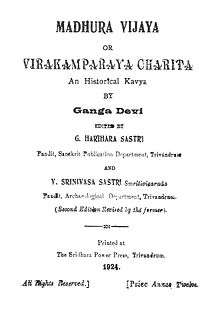Madura Vijayam

Madurā Vijayam (Sanskrit: मधुरा विजयं), meaning "The Conquest of Madurai", is a 14th-century C.E Sanskrit poem written by the poet Gangadevi. It is also named Vira Kamparaya Charitham by the poet. It chronicles the life of Kumara Kampanna Udayar or Kumara Kampanna II, a prince of the Vijayanagara Empire and the second son of Bukka Raya I. The poem describes in detail, the invasion and conquest of the Madurai Sultanate by the Vijayanagara empire.[1][2][3]
Discovery and publication
Madura Vijayam (lit. The conquest of Madura) was discovered in the early 1900s, in a private traditional library at Thiruvananthapuram by Pandit N Ramasvami Sastriar. Sastriar discovered the poem in a bound in a single manuscript between two other unrelated works. Sixty one palm leaf manuscripts have been found so far. The poem is made up of nine chapters with some verses missing and presumed lost. Madura Vijayam was first published in 1924 by G. Harihara Sastri and V. Srinivasa Sastri at Tiruvananthapuram.[4][5]
Content
Madura Vijayam or Vira Kamparaya Charitham (lit. The history of the brave king Kampa) is a poem in nine chapters. In the early chapters, Gangadevi, the wife of Kumara Kampanna II, describes the historical background of the Vijayanagar empire, the benevolent rule of Bukka I, the birth and early life of Kumara Kampanna. The middle chapters detail the adulthood actions of Kampanna, his south bound invasion and conquest of Kanchipuram. After conquering Kanchipuram and subduing Sambuvaraya chieftain, Kampanna enjoys a brief interlude while consolidating his southern conquests. He is visited by a strange woman (described as the Goddess Meenakshi in disguise) who pleads with him to liberate South India from the rule of the Madurai Sultanate.
Heeding her exhortation, Kampanna resumes his invasion of the South. The final chapters chronicle his invasion of Madurai, where he destroys the Muslim armies, slays the last sultan in single combat and restores the temple of Srirangam to its old glory.[2][4]
As a historical source
The poem along with Ibn Battuta's memoirs and epigraphical and numismatic records, has been used as a historical source for determining the history of the Madurai Sultanate and the Vijayanagar empire's conquest of the Sultanate.[6][7]
See also
References
- ↑ Ernst, Carl W. (1992). Eternal garden: mysticism, history, and politics at a South Asian Sufi center (Illustrated ed.). SUNY Press. p. 297. ISBN 978-0-7914-0884-1.
- 1 2 Jackson, William Joseph (2005). Vijayanagara voices: exploring South Indian history and Hindu literature (Illustrated ed.). Ashgate Publishing. pp. 61–70. ISBN 978-0-7546-3950-3.
- ↑ Chattopadhyaya, Brajadulal (2006). Studying Early India: Archaeology, Texts and Historical Issues. Anthem Press. pp. 141–143. ISBN 978-1-84331-132-4.
- 1 2 "A portion from madhurAvijaya". bharatendu.com. 30 October 2008. Retrieved 3 February 2010.
- ↑ Devi, Ganga (1924). Sastri, G Harihara; Sastri, V Srinivasa, eds. Madhura Vijaya (or Virakamparaya Charita): An Historical Kavya (PDF). Trivandrum, British India: Sridhara Power Press. Retrieved 21 June 2016.
- ↑ Aiyangar, Sakkottai Krishnaswami (1921). South India and her Muhammadan Invaders. Chennai: Oxford University Press. p. 184.
- ↑ Sastri, KA Nilakanta (2005) [1955]. A History of South India (Paperback ed.). Chennai: Oxford University Press. p. 241.